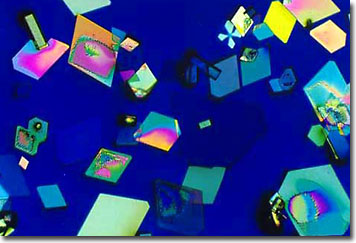Loes Modderman
Betaine-Urea Mixture
Both betaine and urea are naturally occurring organic substances that are also often synthesized by chemical and pharmaceutical manufacturers. Betaine crystals are typically short-lived while urea crystals are relatively stable. Betaine-glycine, the structurally simplest betaine compound, was originally commercially extracted from sugar beets and a variety of seaweeds. Utilized primarily as commercial synthetic fertilizer, urea has the distinction of being the first organic substance synthesized wholly from inorganic ingredients and for nailing the coffin of the ill-fated vitalism theory that attempted to explain the origin of organic chemicals.

As a naturally occurring substance, betaine, in its structurally-simplest form (betaine-glycine), was first commercially extracted from sugar beets. Biochemists found that betaine-glycine was responsible for retaining chlorophyll in the plant cells. Cytokinin (a plant hormone that influences cell division, plant metabolism, and the synthesis of RNA) properties discovered in sugar beets and marine seaweed extracts, have been attributed, at least in part, to betaine-glycine. Through additional extract experiments, betaine-glycine was also found to be a major controller of water movements in and out of higher plant cells, particularly those species adapted for aquatic or salt-stressed habitats. Other betaines have been attributed similar functions in a variety of plants and it is believed that betaine-glycine plays a role in frost resistance.
Betaines occur in the extracts of most species of marine algae, many of which are used as food additives and nutritional/health supplements. While some marine seaweed contains only betaine-glycine, other species feature a mixture of betaines. Betaine surfactants are mixed with weak organic acids, weak organic salts, water, and plant extract to form a mixture that shows promise to help control the foul odors associated with industrial hog farms, commercial chicken operations, sewage treatment plants, and paper and pulp mills. The "pure air" mixture forms bonds with the molecules that produce the offensive odors, typically attributable to organic compounds containing sulfur, chlorine, and fluorine. These reactions form weak organic salts and the odors are largely eliminated, not by masking, but by actually removing the olfactory culprits from the air. Other betaines are derived from coconut oil, molasses, palm oil, and flax or are synthesized in chemical plants.
Urea is produced commercially by dehydrating ammonium carbamate at an elevated pressure and temperature. Industrial applications include the production of aviation fuel and lubricating oils, fertilizers, pharmaceuticals, and polymers. Composed of 45 percent nitrogen and 55 percent inert material (carbon, oxygen, and hydrogen), urea offers a steady supply of sanitary and consistent fertilizer to large-scale farmers and gardeners that do not have a ready supply of animal waste. Also referred to as carbamide, urea is a metabolic waste product that results from breaking down proteins into amino acids and their constituents. Since ammonia is toxic to cells, urea is a convenient, relatively non-toxic compound that can be eliminated in urine safely through the kidneys. On the other hand, fish and other aquatic organisms can directly discharge ammonia into their surrounding milieu, avoiding the extra metabolic step. Birds and similar animals, which are conservative in their water balance, eliminate solid metabolic wastes in the form uric acid, rather than liquid. An adult human typically excretes about 25 grams of urea per day in about 1,500 milliliters of urine, while a dog may range from 65 to 400 milliliters of urine per day, depending on its breed and diet.
BACK TO LOES MODDERMAN GALLERY
